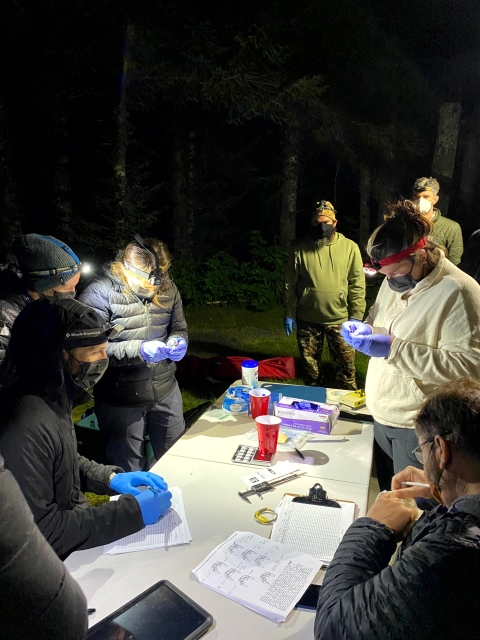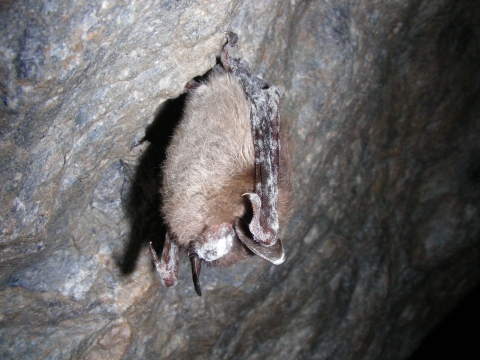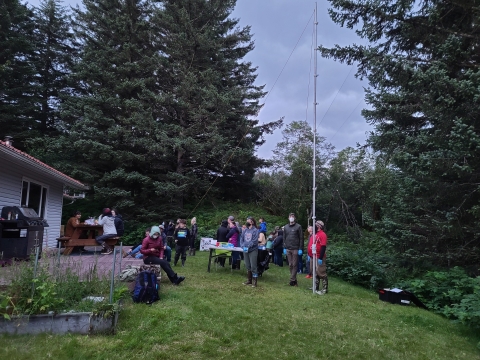Bats serve as important ecological drivers around the world. In Alaska, they significantly help control insect populations. The seven known species of bats in Alaska are the little brown bat (Myotis lucifugus), Keen’s myotis (M. keenii), California myotis (M. californicus), long-legged myotis (M.volans), silver-haired bat (Lasionycteris noctivagans), hoary bat (Lasiurus cinereus), and Yuma myotis (M. yumanensis). The little brown bat is the most common bat throughout the state and the only known bat species in the Kodiak Archipelago.
In July 2022, Kodiak National Wildlife Refuge staff kicked off Bat Week, in coordination with the National Park Service and UC-Davis, which included the initiation of the first-ever little brown bat research on the island. During Bat Week, the refuge hosted wildlife ecologist Jesika Reimer. With her help, the refuge led several outreach opportunities including a series of informative, hands-on public programs focused on bats. "Bats of the World" and "Bats of Alaska" were two outdoor presentations from which people of all ages learned about bats and their biology. The outreach series included four days with staff-led participation of bat emergence counts and opportunities to observe the mist-netting and banding of bats. Nearly 100 people participated in Bat Week! Journalist Kirsten Dobroth of Kodiak Public Broadcasting KMXT aired a story about Bat Week around the state.
As part of our research, wing tissue samples were collected from 13 bats for genetic analysis, and unique bands were affixed to the arms of 74 bats. These data will be included in ongoing bat inventories throughout Alaska, another first for Kodiak. Refuge staff performed capture surveys at three maternity roosts and handled 76 little brown bats, 60 of which were adult females.
So what do we do with all this information? Our refuge’s research group aims to learn more about little brown bat’s presence, movement, and wintering habitat throughout Kodiak Island, and possibly Alaska. In the western U.S. and especially Alaska, very little is known about their wintering habitats and migrations. We aim to learn the origin of Kodiak’s bat population and if they are exchanging genetic material with other Alaskan populations. This will aid in hypothesizing if and when we should expect Kodiak bats to be infected by White-Nose Syndrome (WNS) and how to better prepare for it. Ultimately, our goal is to develop management plans for mitigating WNS.
WNS is a disease that is sweeping through North American bat populations. Little brown bats are especially vulnerable because they winter-roost in places where conditions are idyllic for WNS, caused by a fungus that invades hibernating bats. It appears around the nose and on wing membranes, and so is easily transmitted to other bats through social contact. This fungus leads to disturbed hibernation, which in turn causes the rapid use of fat reserves, dehydration and, ultimately, death. WNS has not yet reached Alaska, but our warming climate suggests bats may experience it here soon.
Kodiak Refuge is excited to be hosting ecologist Jesika Reimer again and expanding our bat research program in 2023. In early August, we plan to mist net and collect genetic information in remote village communities to better understand movement of little brown bats around the Archipelago. Understanding bat movement is imperative for managing WNS in the future. Our team also plans to expand on last years Bat Week with increased outreach and community involvement in the City of Kodiak in mid-August. Keep an eye on our Facebook page for events and information. We look forward to the public joining us as we learn about bats together!








